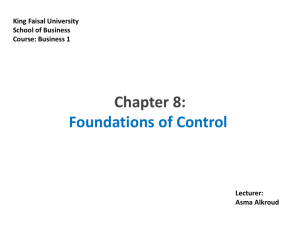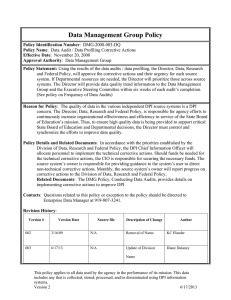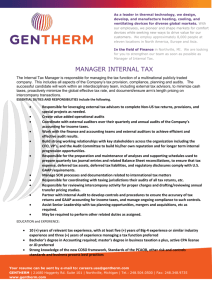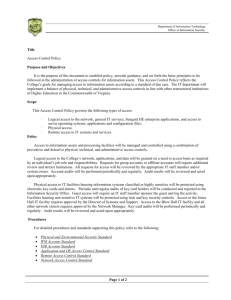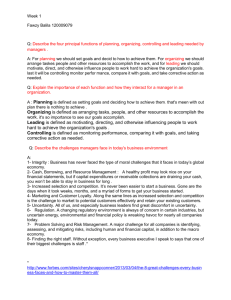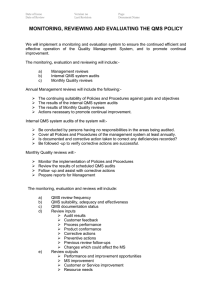Lesson 24
advertisement
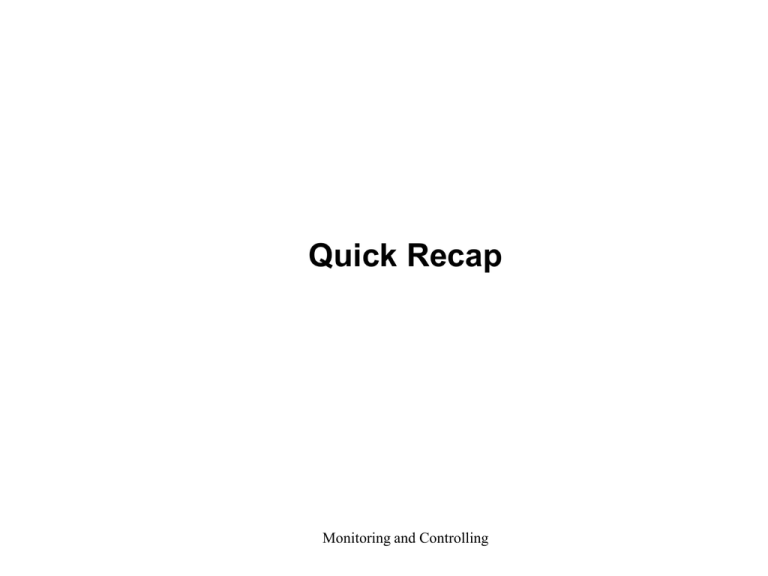
Quick Recap Monitoring and Controlling Procurement Framework STATEMENT OF WORK PROCESS OVERVIEW • The following is a summary of the recommended process steps for preparing a Statement of Work SOW : • Establish a preliminary scope statement ( i.e., the purpose or objective of your procurement) List the tasks to be performed ( i.e., All performance requirements you intend the contractor to satisfy, all requirements that the contractor must comply with during contract performance ) Group similar and related tasks. Organize the tasks in logical sequence Identify the input ( Required resources to perform the tasks) Identify the output ( Required results or deliverables ) Identify the timeline or frequency of the deliverables (output) Develop the parameters for acceptable quality and performance Determine how you will monitor the deliverables • • • • • • • • Lesson 11: Monitoring and Controlling Project Work Topic 11A: Identify the Monitor and Control Project Work Process Monitor Project Progress and Make Corrections Process to monitor and control project execution 5 Monitoring, Evaluation, Controlling Project Monitoring, ”Evaluation”, and Control • Control is a management function which is the process of monitoring, avaluating and comparing planned results with actual results to determine the progress torward the project cost, schedule, and technical performance objectives, as well as the project's ”strategic fit” with enterprise purposes. • It's role is more predictive than investigative and answers the question what may happen according to the management type than what has happened Steps in control cycle (1) Establishing standards (4) Taking corrective action (2) Observing performance (3) Comparing actual performance Performance standards • Performance standards are based on the project pan, including at minimum the expectations for the project, established in the project objectives, goals, strategies, relative to project cost, schedule, technical specifications and strategic fit. • Key standards include: - Scope of work - Project specification - WBS !!? - Work packages - Cost estimates and budgets - Quality - Project team satisfaction - Resource utilization Performance observation • Performance observation is the receipt of the sufficient information about the project to make an intelligent comparison of planned and actual performance • Information can be obtained either from formal sources like reports, briefings, participation in review meetings, letters; or from informal sources such as casual conversations, listening to rumors or gossip etc. Comparing planned and actual performance • During this comparison we have the opportunity to answer three key questions: - How is the project going? - If there are deviations from the project plan, what caused these deviations? - What should be done about these deviations? • It is the responsibility of the project team and the senior managers • Its the basis for reaching a judgment about the project's status and whether corrective action is required Corrective action • Corrective action can take the form of replanning, reprogramming or reallocating resources, or changing the way the project is managed and organized • Corrective actions center on the cost, schedule, and technical performance parameters • Correcting a problem with one of the parameters of the project may have reverberations on one or both of the other parameters, thus alternatives should also be considered Monitoring and evaluation • Monitoring is to keep track of and to check systematically all project activities. • Evaluation is the examination and appraisal of how things are going on the project. • Monitoring and Evaluation of the project require that the project team look inward to the project and the sponsoring organization as well as outward to the stakeholders and the general ”system” enviroment. Evaluation • A framework for doing the evaluation can consist of a series of key questions about the project which must be answered on an ongoing basis. • Project team meetings should be done regularly so that team members could think about these questions more often • Example of questions: - What is going wrong? - What opportunities are emerging? - Is the project making money for the company? Success and failure examples • NASA's upper atmosphere research satellite was kept on cost and schedule in part because the project team combined political savvy with technical conservatism to guard the project from controversy. In addition good planning was also a factor in controlling the use of the resources correctly. • EOS enviromental satellite was $13 billion above its original cost projections and 5 years behind schedule due to its managers overestimating their political support and underestimating the technical challenge. The project became mired in controversy. Management Function Evaluation • Management-related activities can be used to adress representative key questions to evaluate the project. • Sorted by category: - Project planning - Project organization - Program management process - Project accomplishments - Project information Project planning • Are the original objectives and goals realistic? • Is the plan for the availability of project resources adequate? • Are the original project schedule and budget realistic? • Are there adequate project control systems? • Was facility planning adequate? • etc.. Project organization • How effective is the current organizational structure in meeting the project objective? • Does the project manager have adequate authority? • Is the organization o the project office staff suitable? • Have the interfaces in the matrix organization been adequately defined? • Do key project stakeholders understand the organization of the project office? • Have key roles been defined in the project? Program management process • Does the project manager adequately control project funds? • Are the project team personnel innovative and creative by suggesting project management improvements? • Does the project manager maintain adequate management of the project team? • Do the project team people get together on a regular basis to see how things are going? • etc.. Project accomplishments • To what extent have the original project goals been achieved? • How valuable are the technical achievements? • How useful are the organizational and/or management achievements? • Are the results being implemented? • Are the users being notified properly? • Is the customer happy with the project results to date? Project information • Key systems can provide key information on the status of the project which is necessery for the operations of the project team • Such systems are: - An equipment, labor, and material IS - A cost control system - A schedule control system - A budget/financial planning/commitment approval system - A work authorization system - A method of using the collective judgment of team members to judge the progress being made When to monitor and evaluate • Monitoring and evaluation of a project is done throughout its entire life cycle • There four major types of project evaluation: 1. Preproject evaluation 2. Ongoing project evaluation 3. Project completion evaluation 4. Postproject evaluation Planning for monitoring and evaluation • Part of the project planning should include the development of a strategy on how the project will be evaluated during its life cycle. • Evaluations should be done on a periodic basis • This way it is visible for the stakeholders that the principal managers have a concern for the degree to which the project objectives and goals are achieved and an important message is sent throughout the organization Who monitors and evaluates? • The responsibility rests withe project team and the project owner. Also the manager who has ”general management” or ”project owner” jurisdiction also shares in the residual responsibility. • This process is done at many levels such as: - The individual professional's level - The work package level - The functional manager's level - The project team level - The general manager's level - The project owner's level Project Audits • Project audits provide the opportunity to have an independent appraisal of where the project stands and the efficiency and effectiveness with which the project is being managed. • Audits can be planned periodicly, but also requested when there is a sense that the project is in trouble, or when a new manager takes over in order to become accustomed with the project. • Project audits should: - Determine what is going right or wrong, and why - Identify forces and factors that have prevented achievements of cost, schedule, and technical performance goals - Evaluate the efficacy of existing project management strategy - Provide for an exchange of ideas, information, problems, solutions, and strategies with the project team members Responsibilities of the audit team • Critical review of the project documentation • Interview of the project team and other project stakeholders to gain insight into their perceptions of the project affairs • Participation in enough of the project activities to gain an appreciation of what is going on regarding the project and insight into the project problems and opportunities • Preparation and submission of a final audit report and the debriefing of the project stakeholders on the results of the audit Project audits implementation profile (PIP) • Developed by Pinto and Slevin to use in making periodic assessments of the current status of or key factors concerining a project • Ten critical success factors can be measured - Project mission - Top management support - Project schedule/plan - Client consultation - Personnel - Technical tasks - Client acceptance - Monitoring and feedback - Communication - Troubleshooting Postproject reviews • PPRs are used in order to evaluate the efficiency and effectiveness with which projects are managed • Such reviews have become commonplace to determine which project costs have been incurred reasonably in the nuclear plant industry • At British Petroleum, these reviews have become an integral part of the corporate planning and control process • Teams perform a better job of managing a project when they know that they will be evaluated Conceptual phase Strategic fit Broad perspectives Project justification phase Financial analysis Specific market outlook Pre-approval audit phase Validation of key assumptions Approval phase Approval by top management Appropriation phase Authorization to spend money Construction and start-up phase Implementation of the project Post-completion review phase Interim review Full review Mini review Configuration management and control • Configuration control regulates changes that are made in a system, which if not properly done could reverberate throughout the rest of the components of the system, causing problems with budges, schedules etc.. • Configuration management is the discipline which integrates the technical and administrative actions of identifying the functional and physical characteristics of a system (or product) during its life cycle • Configuration management compirses three major areas of effort: Configuration identification, status accounting, and control Configuration identification • Configuration identification is the process of establishing and describing an initial system baseline, which in turn is described in technical documentation • The concept of a baseline system requires that the total system requirements and the requirements for each item of the system be defined and documented at designated points in the evolution of the system Configuration status accounting • Configuration status accounting is the process of recording and documenting changes to an approved baseline to maintain a continuous record of the status of individual items that make up the system • Also shows what actions are required and what engineering changes are complete Configuration control • Configuration control is the process of maintaing the baseline identification and regulating all changes to that baseline. • The configuration control board can provide a singlepoint authority for coordinating and approving engineering change proposals • Such engineering changes have two potential costs. The first is the direct cost of the change itself while the second is related indirectly to the change order, or the ”ripple effect”, e.g., additional supervisions, consequential damages, etc..
